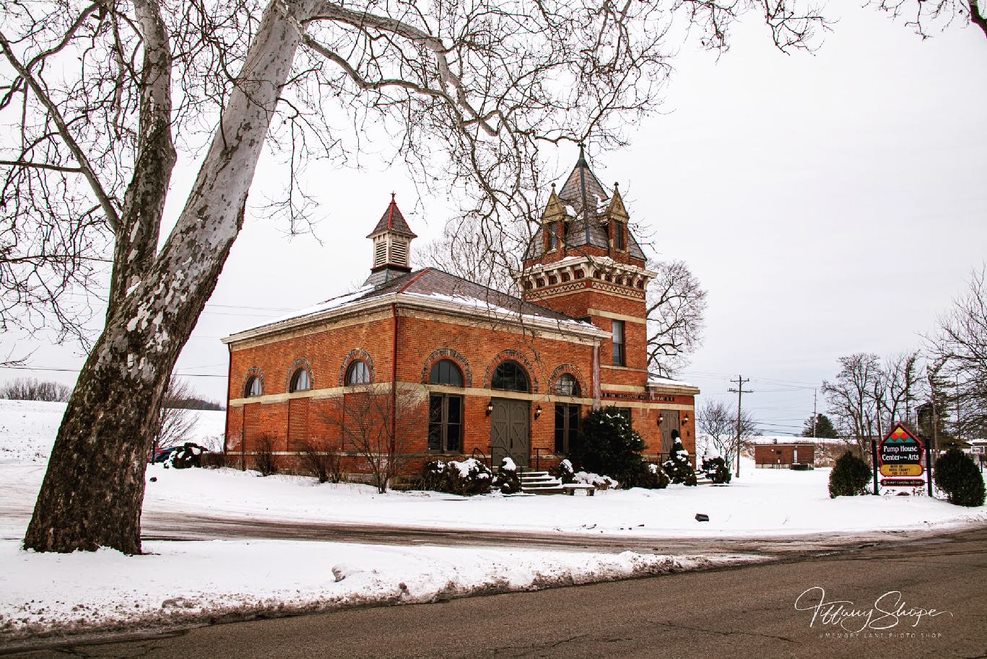
How a 19th Century arts center remains a staple in the Chillicothe community
Pump House Center for the Arts in Chillicothe is one of the city’s oldest buildings with a history dating back to the 1880s. The building was initially constructed for the city to have a centralized water system after a widespread fire in 1856. Sitting along the Scioto river in Yoctangee Park, the water pump house was opened in 1883. The Teays aquifer, a body of permeable rock that holds groundwater, was the main water source at the time, however the city uses other aquifers in the same spot for drinking water to this day.
Pump House History
According to the Pump House Center for the Arts website, the pump house was closed in the 1930s because the city deemed it “insufficient” as the population grew, and indoor water taps became more popular. The building sat vacant for years after the pump was no longer used. The city government thought it would be a suitable place to hold salt in the winter because the physical structure already had a lot of wear and tear. It was not until the 1970s that the city decided the building was beyond repair and needed to be torn down. John Payne, who is now the director of the art gallery, along with a friend saw potential in the building. They wanted to preserve it, so they brought the issue to the city council.
“We had an interest in historic buildings. We both lived in historic structures at the time,” he says. The pair approached the Chillicothe Jaycees, a volunteering organization serving Chillicothe, about the building. The former president, Randy Loechert, suggested to put on a haunted house to utilize the space and make money for their organization, something his own hometown had done. Payne took this idea and ran with it to city council with the hopes of swaying the decision. “We convinced them to lease us the building for a dollar and we started running haunted houses out of it,” Payne says. The haunted house operated seasonally for about five years, but in 1984, the building was condemned due to holes in the structure. Moreover, the old pump house was leased to a board of trustees in 1986.
A group of artists led by Ted Fickisen were able to raise almost $160,000 for the projected repairs, with the help of numerous volunteers. Before he died in 2017, Wilbur Poole, previous owner of Ingle-Barr Inc. Construction Services, utilized his own business and transformed the building into a functioning art gallery. Poole agreed to work on and repair the building with the agreement that he only be paid back when it was possible.
On Aug. 3, 1991, the Pump House Center for the Arts was officially opened as an art gallery. Poole’s efforts and contributions to the art gallery were not forgotten, and one of the two showrooms was named after him. The other is named after Fickisen, who is credited with the idea of transforming the pump house into an art gallery.
Present-Day Transformation
Today, the Pump House Center for the Arts is a functioning art gallery, with different types of paintings and photographs, as well as items for sale from local artists and businesses. In the gallery dedicated to Poole, works from local high school students are featured each month. The art is always changing. Local products and art by local artists are for sale in the gallery dedicated to Fickisen and in the gift shop. Tiffany Shope discussed her experience featuring her work and working with the Pump House volunteers. “It was great. Everybody is super nice and they’re all volunteers, they don’t get paid,” she says.
Shope’s photos were displayed in the art gallery over the holidays, however, her photos have been for sale in the gift shop. Her photography consists of nature, wildlife and abandoned buildings. Shope also runs a photography business where people can schedule to get their own pictures taken.
The history of the old pump house shapes the art gallery to be what it is today. It was the work of the volunteers over time that helped grow the art gallery, and it is the work of the artists, members and board members that keep it running today.